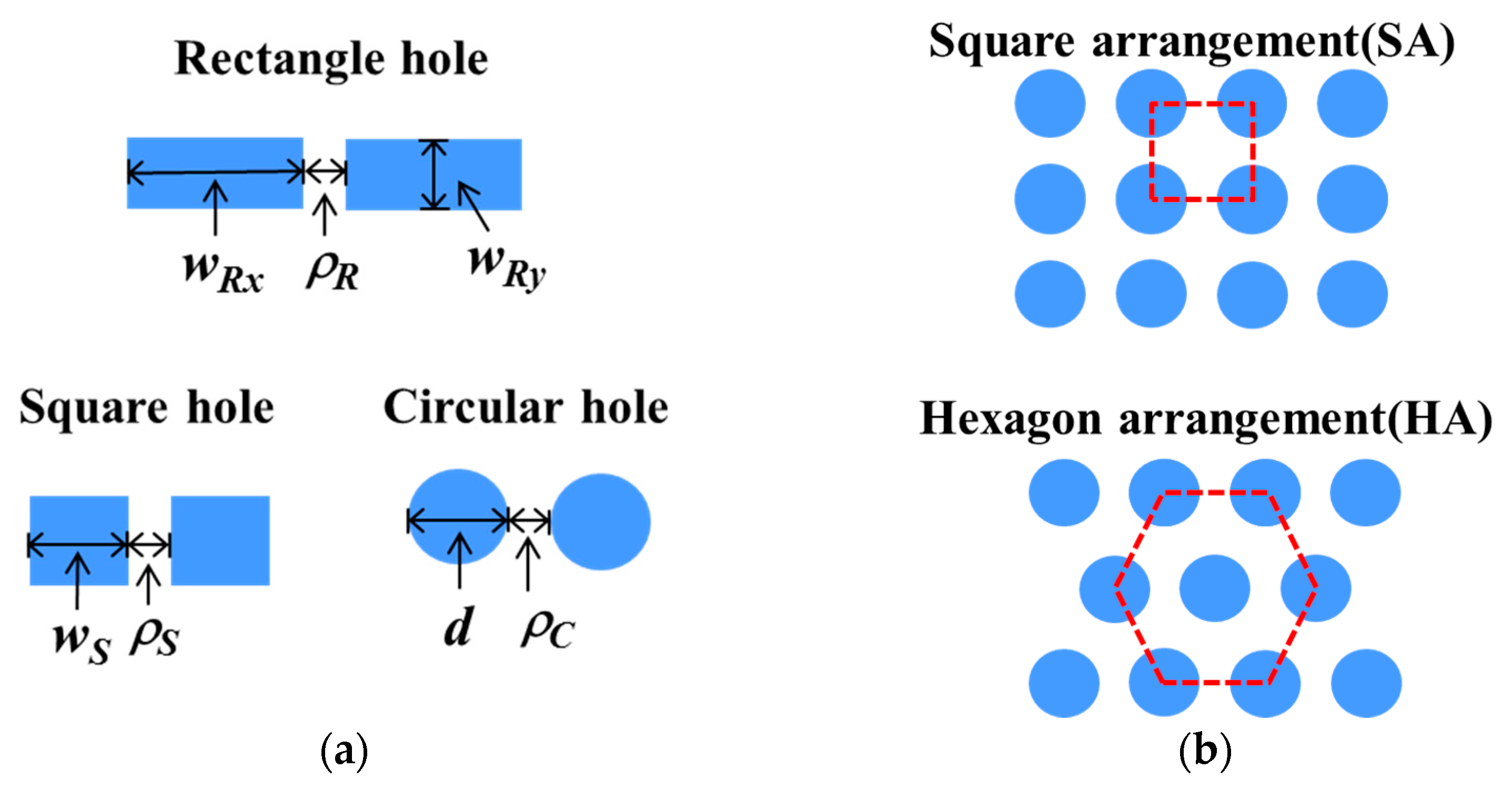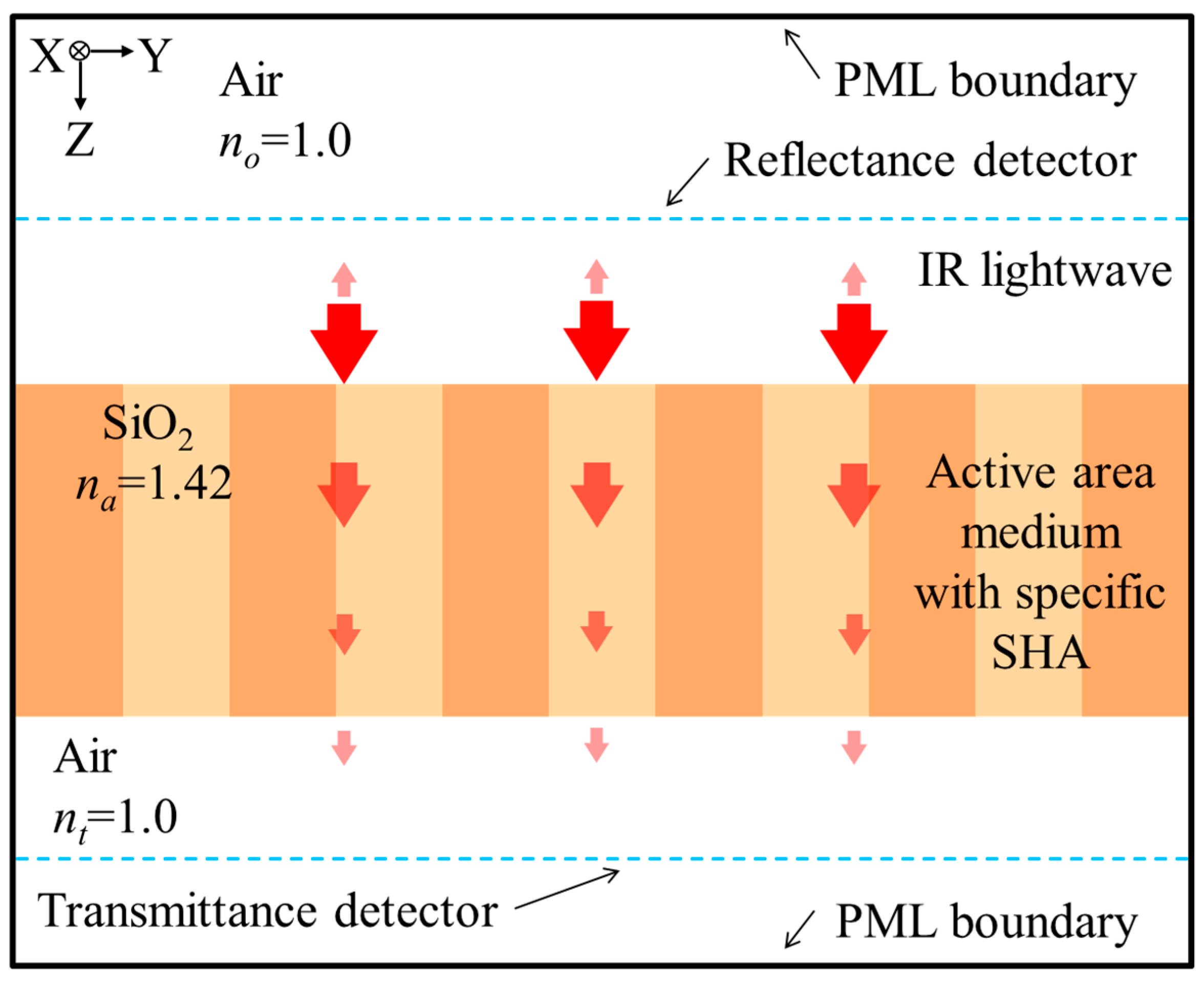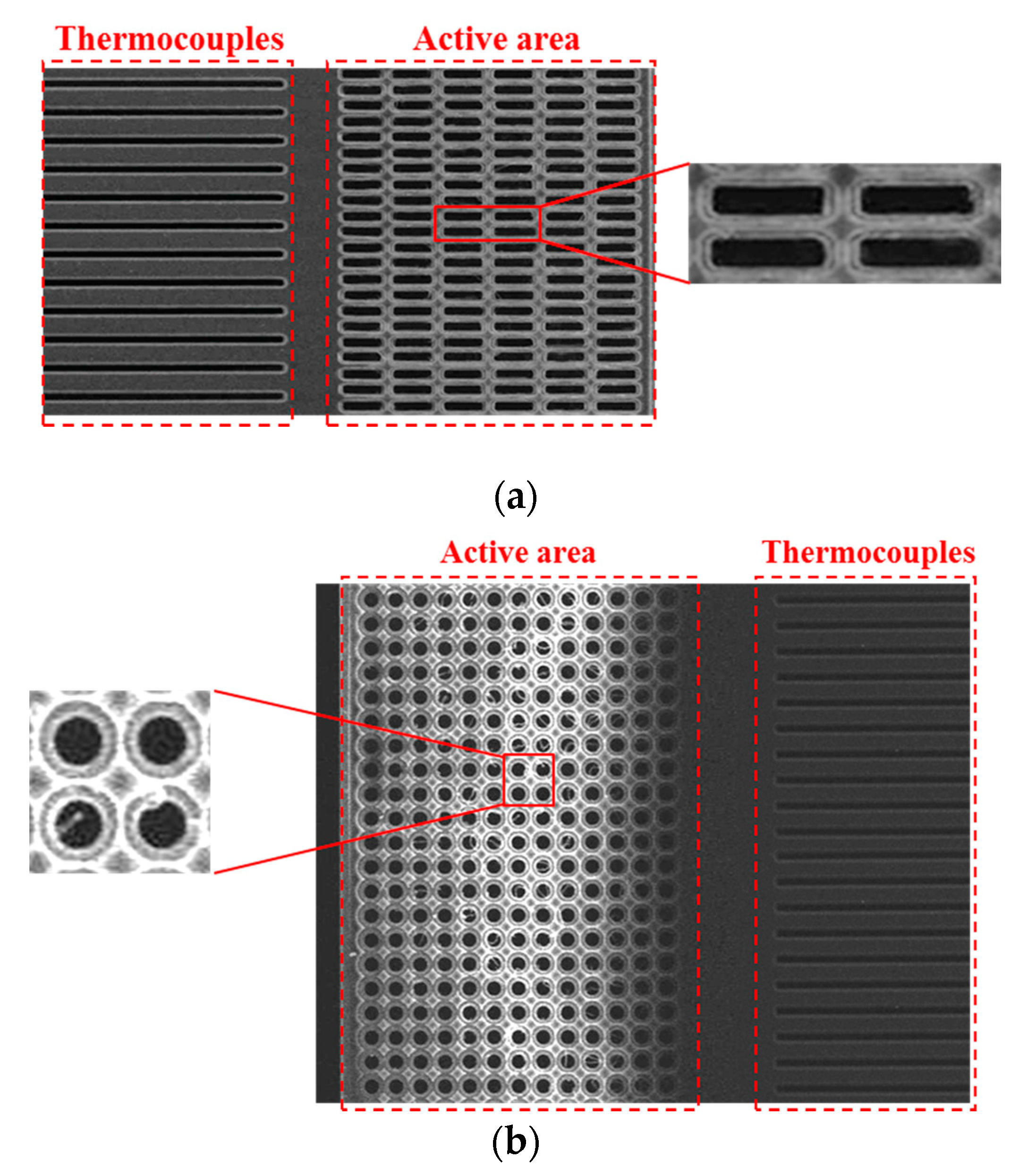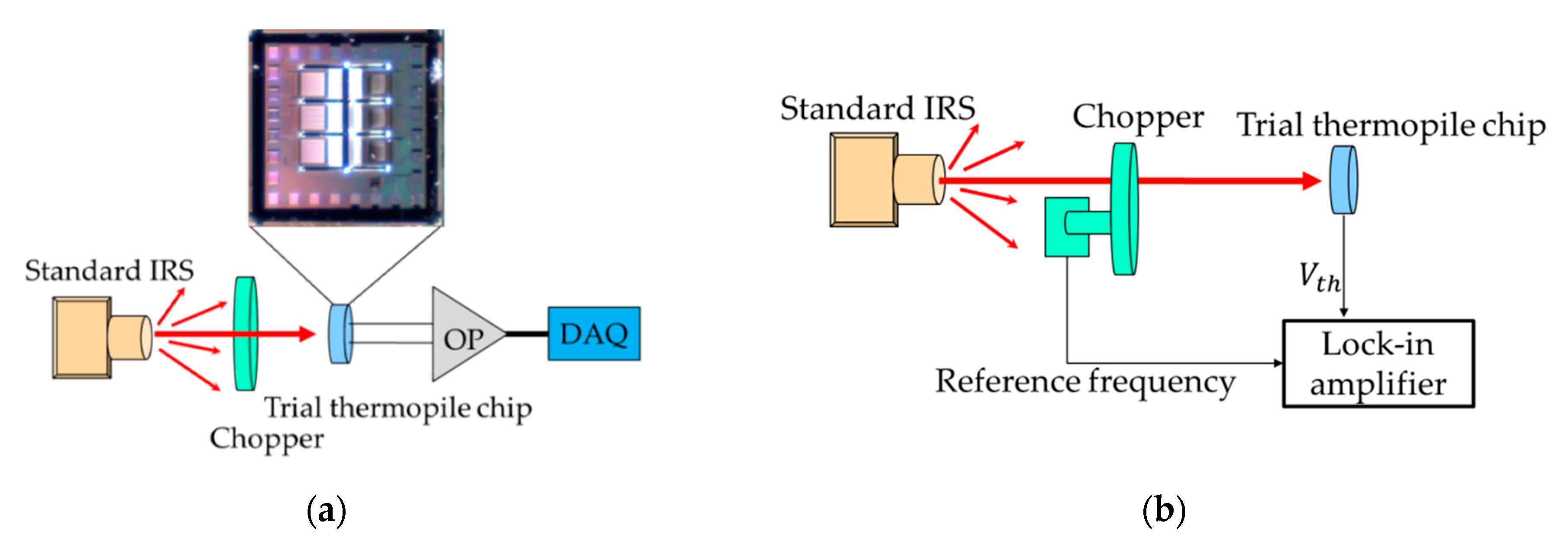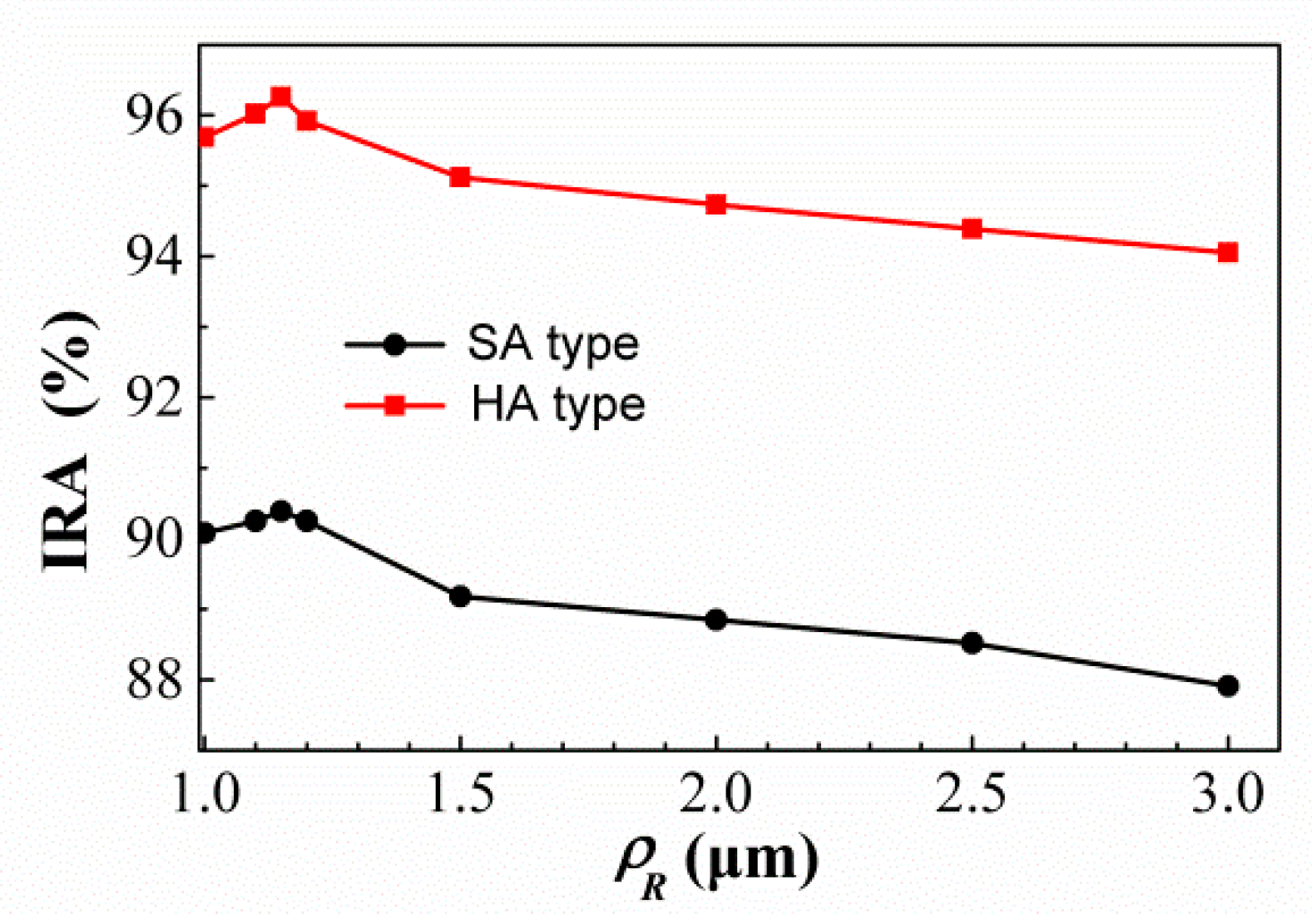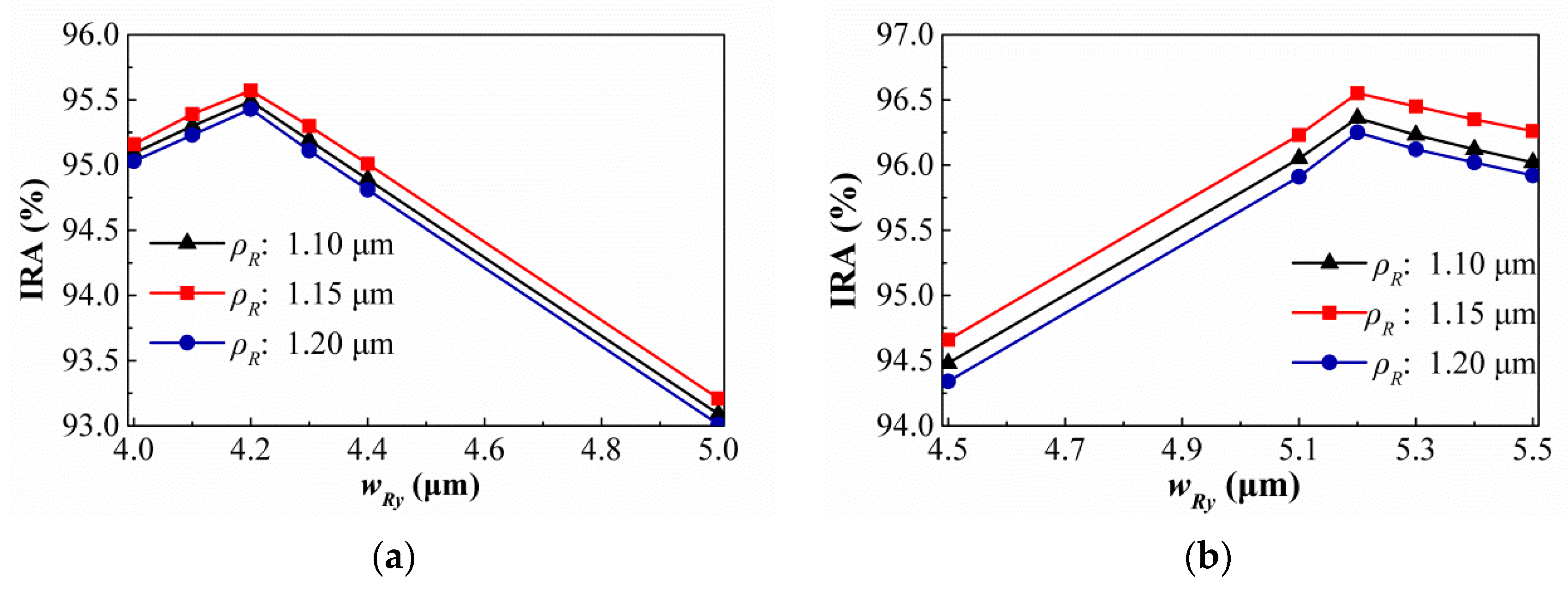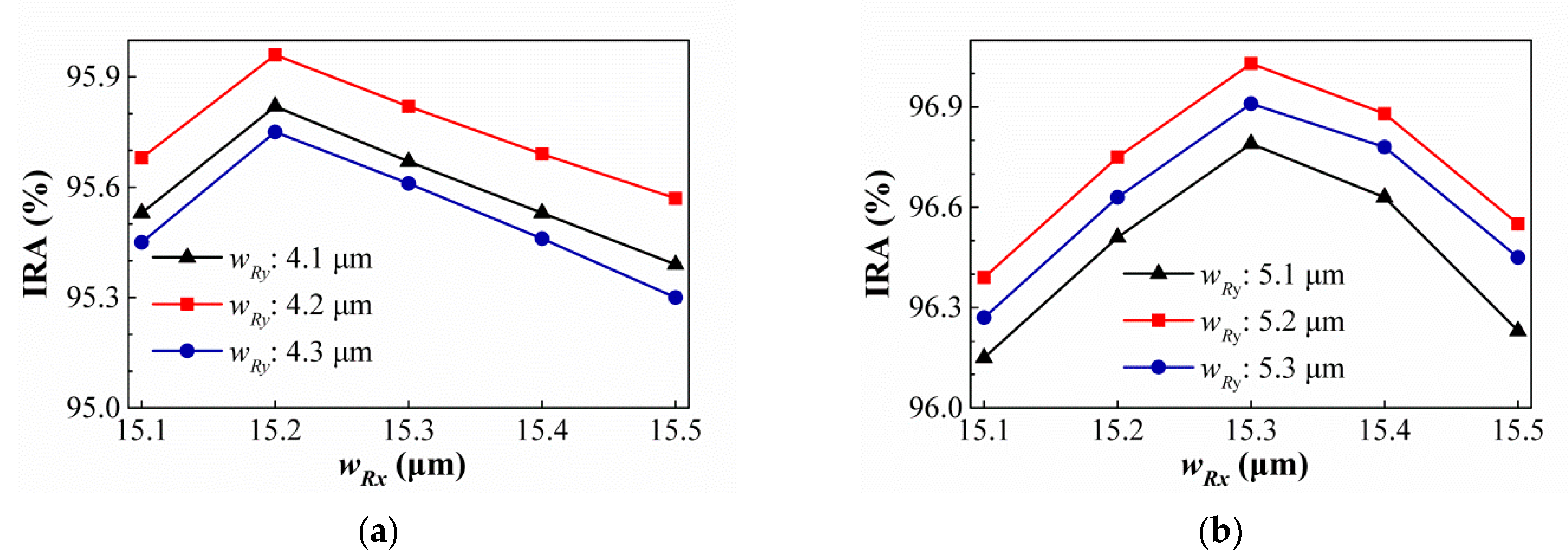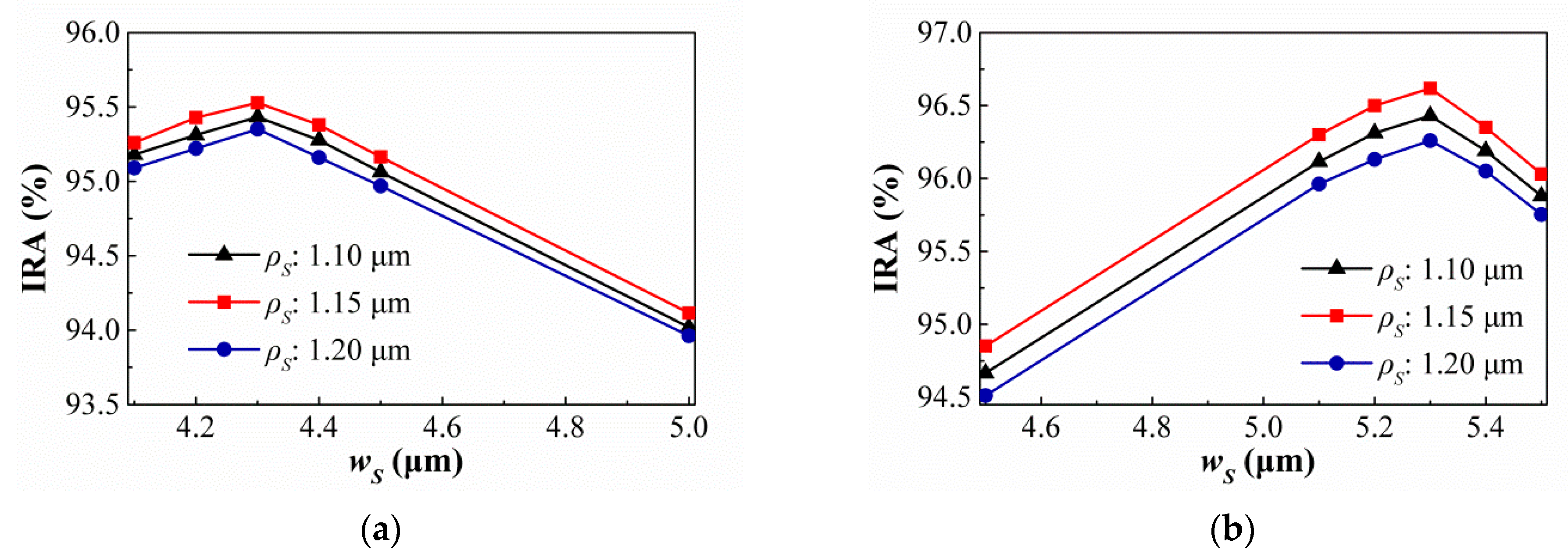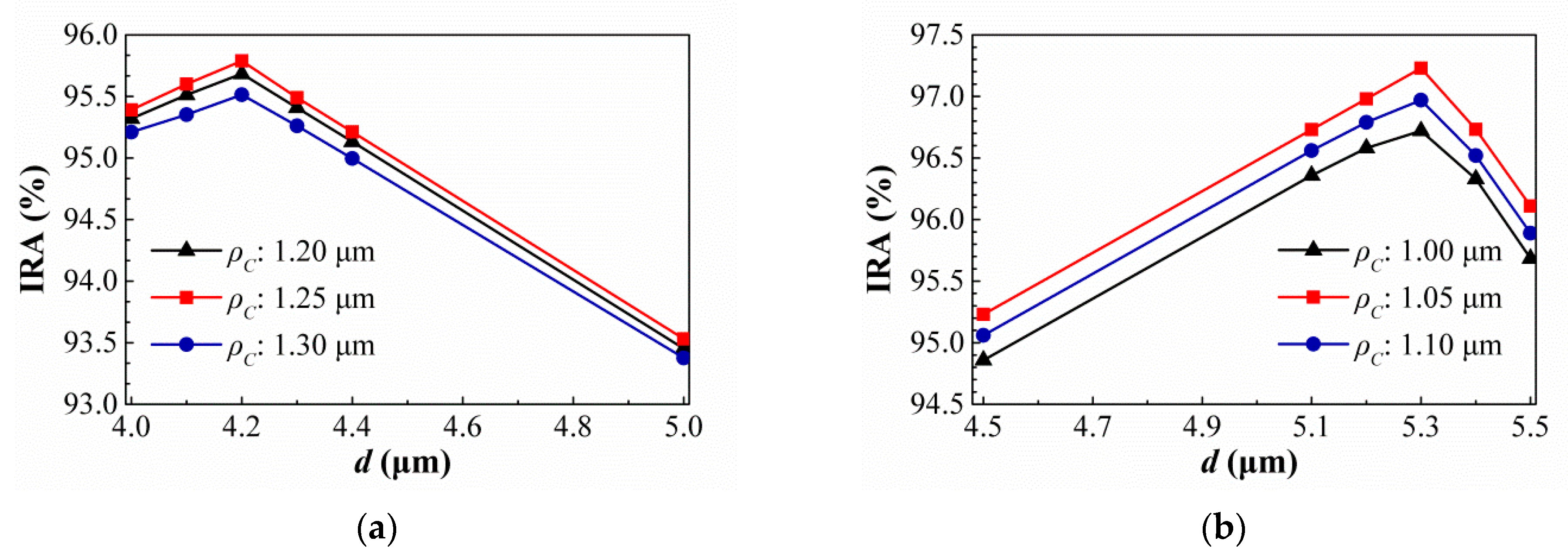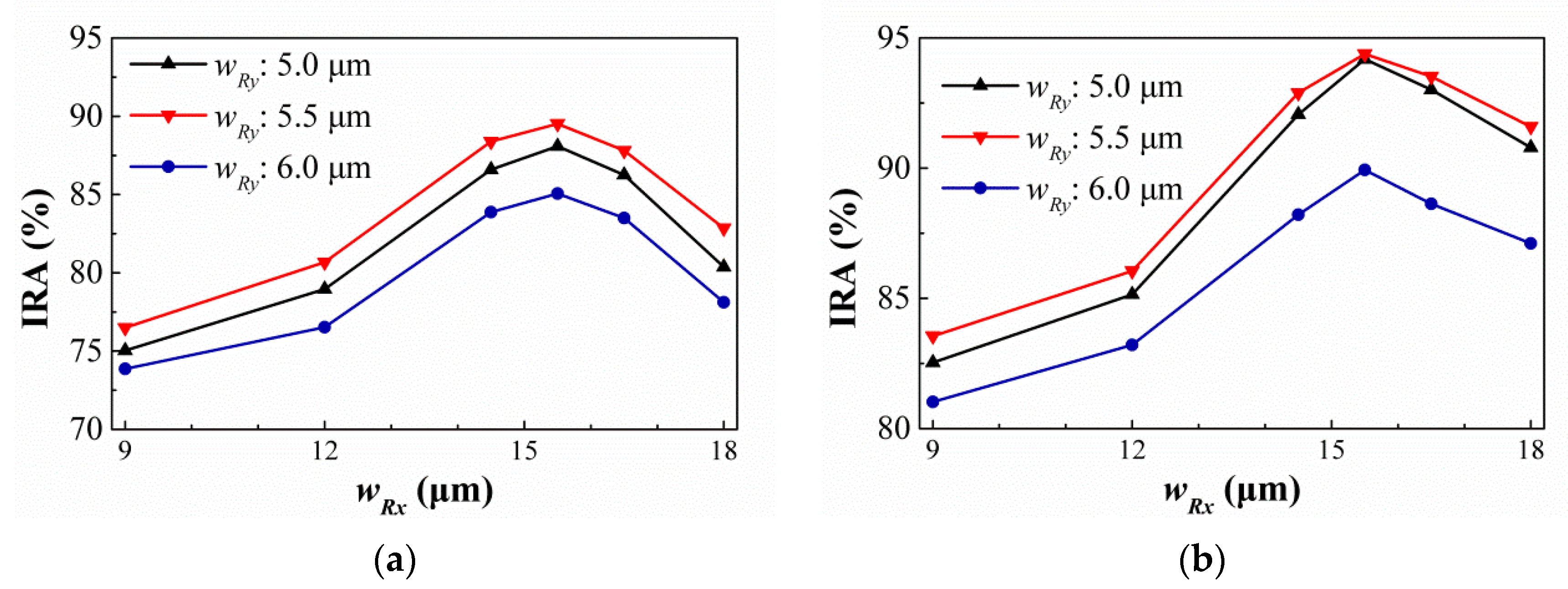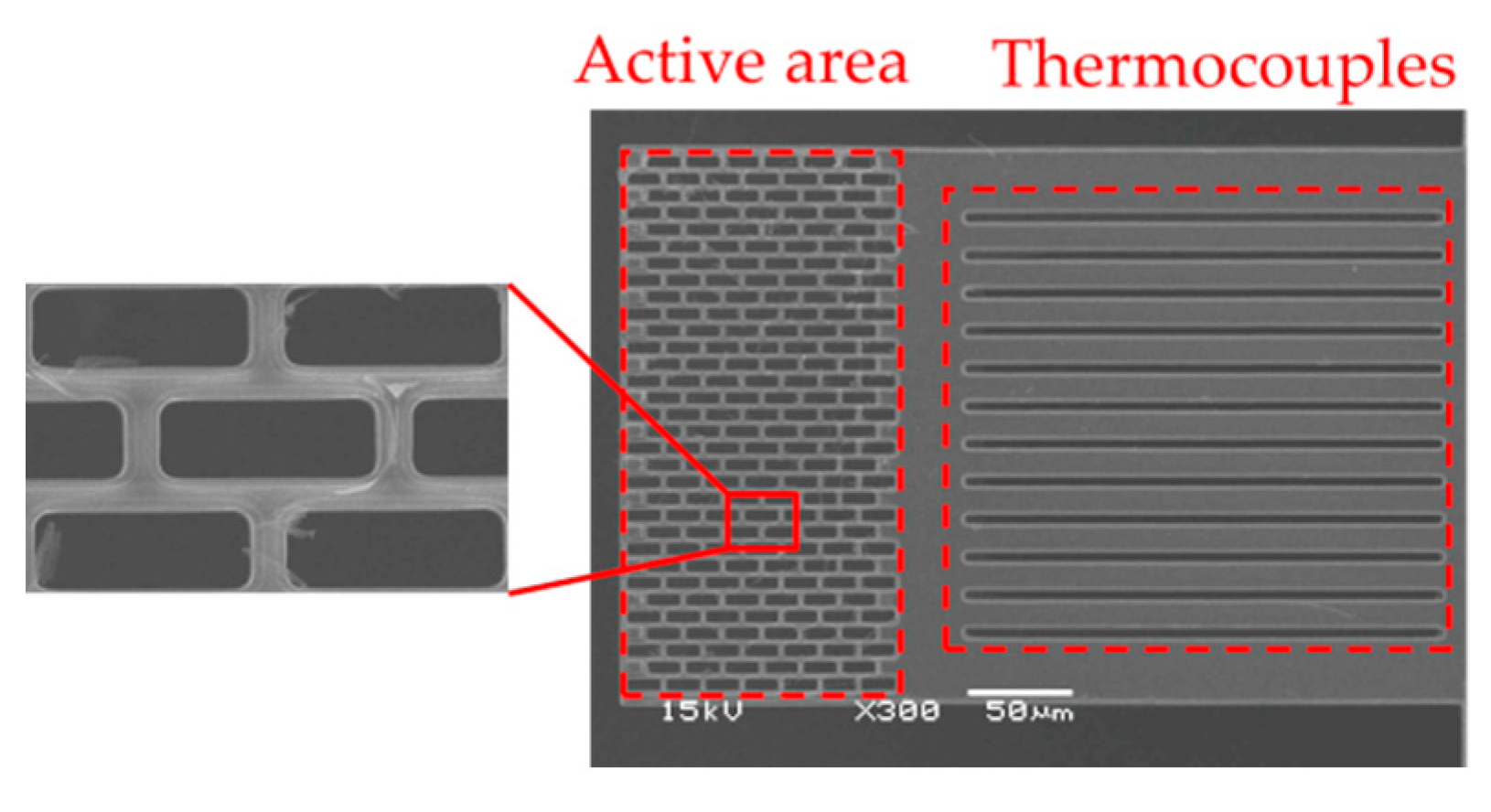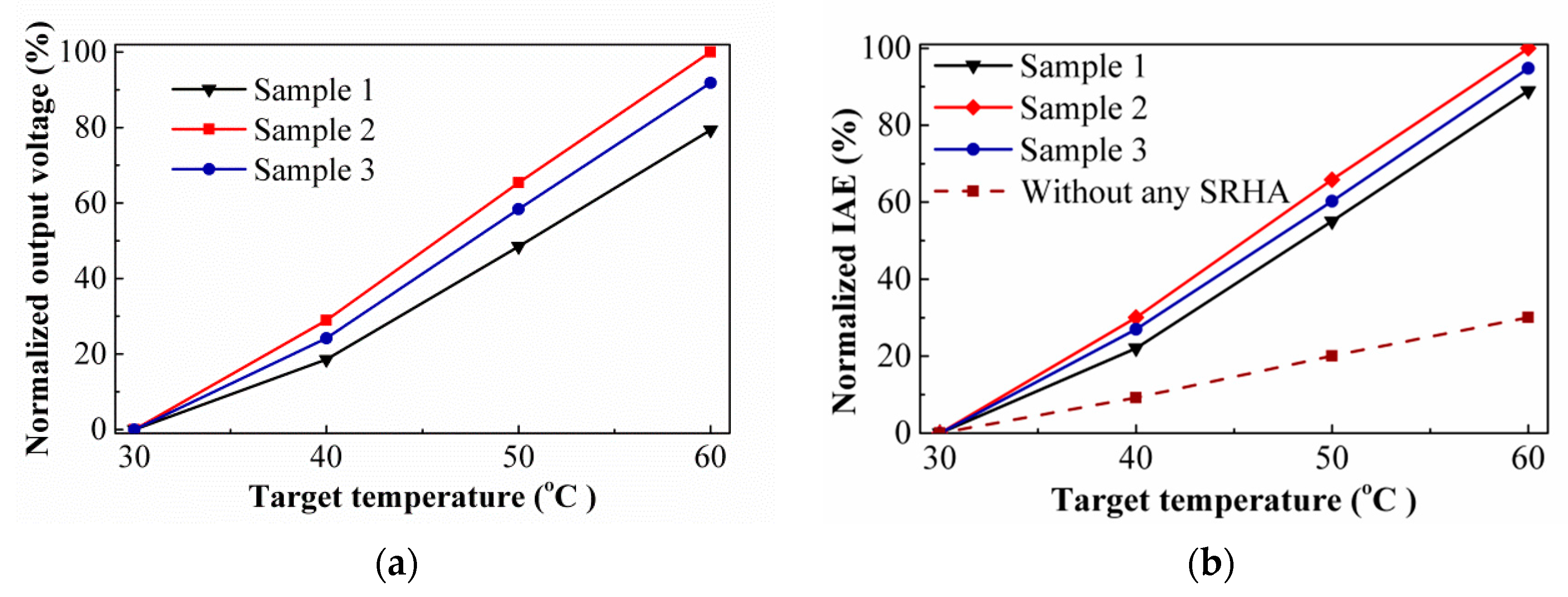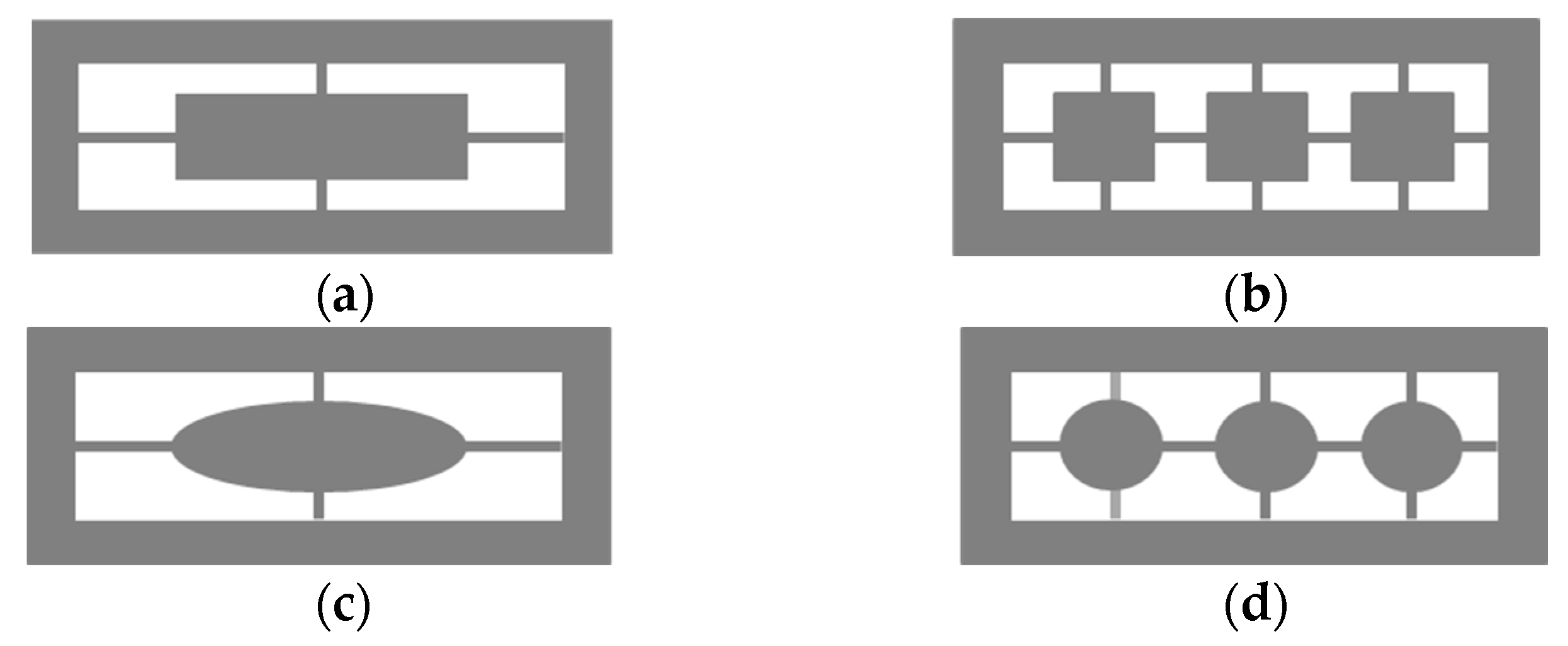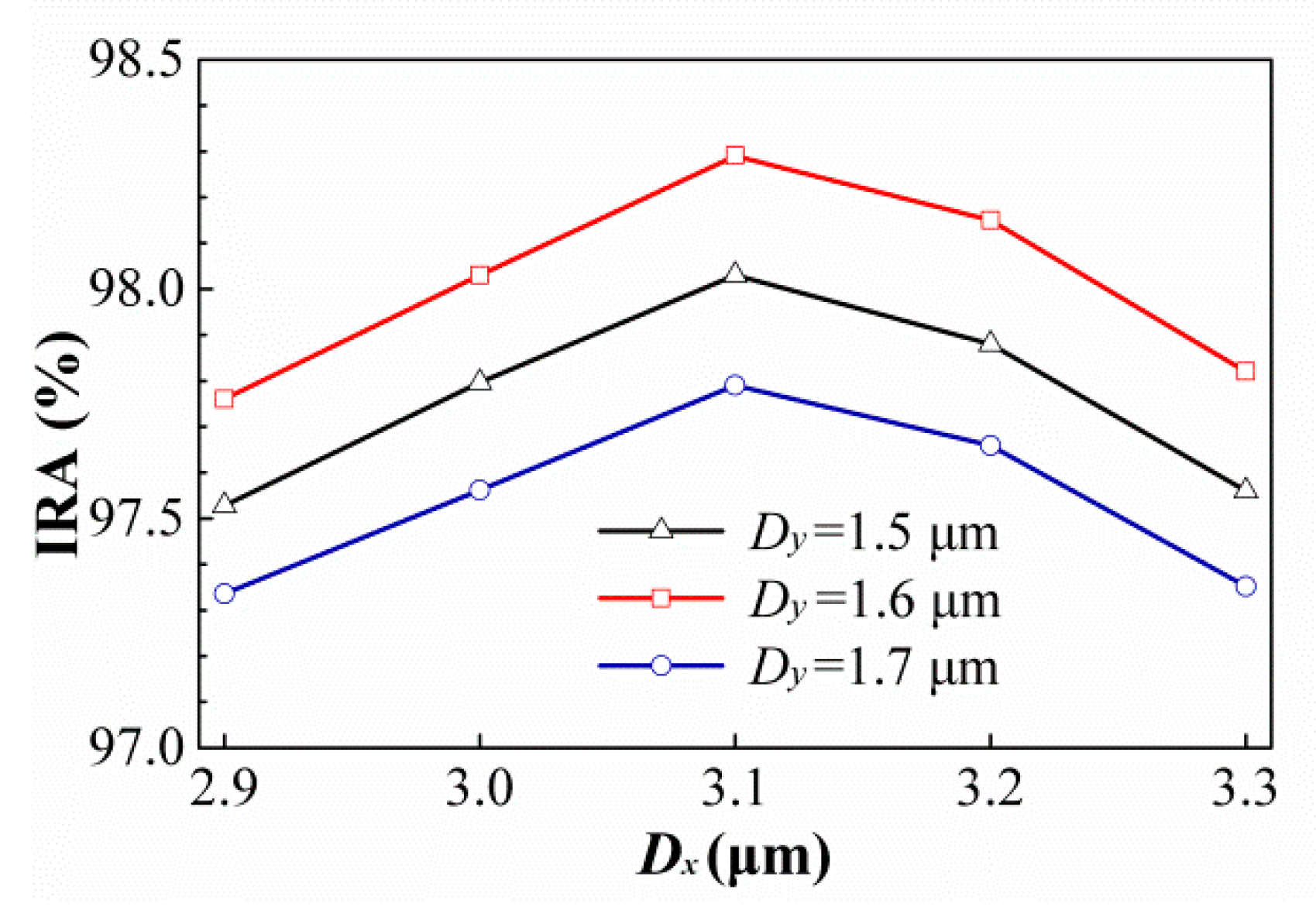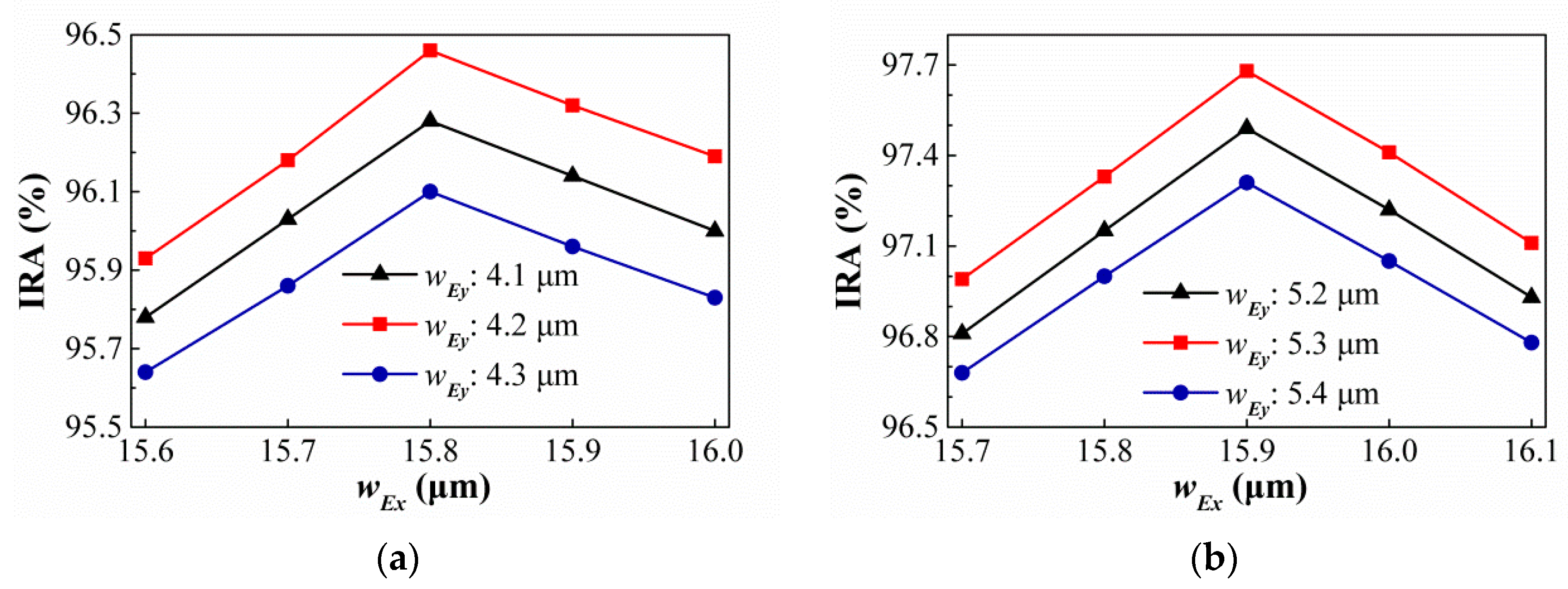1. Introduction
The temperature sensor is a kind of sensor that was developed very early, widely used and most commonly used. Especially in this century, there are many diseases that endanger human life, such as influenza, severe acute respiratory syndrome coronavirus (SARS-CoV), and coronavirus disease 2019 (COVID-19) [
1]. Fever is one of the main symptoms of these diseases. Without avoiding virus infection, non-contact temperature sensors are gradually becoming [
2]. In addition, the non-contact temperature sensing device or non-contact temperature measuring instrument also has the application characteristics of measuring the surface temperature of moving objects, small measurement targets, small heat capacity or rapid temperature changes, and measuring the temperature distribution of the temperature field [
3,
4]. According to Stefan-Boltzmann law, infrared (IR) sensors (IR sensors for short) are often used as non-contact temperature sensors [
3]. Mainly served as the temperature measurement device, the thermopile delivers the output voltage in response to remote temperature, such as an infrared thermometer widely used by medical professionals to measure body temperature, or in a thermal accelerometer to measure the temperature curve in the sealed cavity of the sensor. In particular, it is also very suitable for remote temperature sensing [
5] and non-dispersive infrared sensing (NDIR) gas detection [
6,
7].
These IR sensors mainly include thermal-type detectors such as thermopile, bolometer or pyroelectric detector to detect the change of temperature on the element for measurement through thermal radiation exchange between the targets and environment. The temperature under thermal equilibrium will then be converted into a measurable detector electrical signal. In particular, the sensing wavelength range of these thermal radiation generally covers a very wide infrared spectral range.
In recent decades, many research and development trends have been realized in standard CMOS (complementary metal oxide semiconductor) processes for the fabrication of IR sensors. Due to the maturity of the process and compatibility with standard CMOS technology, the literature reviews the use of CMOS-MEMS technology to promote the development of IR components, which has been proven to be particularly effective in the development of SOC (system on chip) technology [
8,
9,
10]. Therefore, this research aims to improve the sensitivity of CMOS-MEMS IR sensors to realize the development of high heat radiation absorption technology [
11,
12,
13,
14,
15]. CMOS-MEMS thermopile is composed of multiple thermocouples (in series), and the weak voltage signal generated by each pair of thermocouples will be added and output to the next stage of amplifying sensing circuit. The final output signal can be used for measuring the amount of IR radiation absorbed by the detector [
16,
17].
Among these studies, the research issues of infrared absorption technology mainly are focused on improving the absorption efficiency and sensitivity of the sensing film. Among these research, the interference-type ultra-thin metal film or quarter-wavelength structure [
18,
19] above the sensing area are fabricated through the sputtering or evaporation process, which can enhance the absorption of IR heat radiation within a specific range. This thin film process is compatible with semiconductor processes and proceeded after the fabrication of device. Related similar processes also include the use of thermal coating of deposition to produce high-porosity or gold-black structures to improve the bandwidth of IR absorption coatings [
20]. The advantage of this technology is a broad absorption spectrum, so it provides a better sensing signal for commonly used for the thermal radiation thermometers. At the same time, it is reported that some studies have also focused on the deposition and filling of the polymer coating of particles [
21]. In addition, the exploration and research of new materials with high spectral absorption are still proceeded.
In the above studies, although the way of realization and production is different, the enhanced absorption layer improves the sensing efficiency of thermal radiation. Most of these studies have the following characteristics: (i) higher responsively and wider absorption spectrum, (ii) The structural design has a small heat capacity, (iii) the heat dissipation structure has a better conductivity, (iv) the device has long-term stability and repeatability in operation, (v) the manufacturing process of the device is compatible to the material deposition [
22]. These characteristics show the main issues to be considered in the development of infrared thermal radiation sensing films.
In these research topics, due to the continuous development and research of new materials and the innovative progress of research, new features and methods are provided for the development of sensing materials in infrared components. In 2013, the research work by Mikyung Lim et al. proposed to coat a single atomic layer of graphene on a doped silicon substrate. This study revealed that it can increase the radiant heat flux between two plates [
23] and it also shows that the new material, graphene, has a sp
2-hybrid honeycomb two-dimensional carbon lattice composed of conjugated hexagonal cells, and shows a higher heat radiation absorption capacity, which is a higher emissivity performance.
Generally, when applied to a remote temperature measurement ranging from room temperature to hundreds of degrees, the main sensing radiation wavelength of the IR sensor covers a range of approximately several microns to several tens of microns. In other words, for CMOS-MEMS technology, the structure pattern and size corresponding to the wavelength response of the IR sensor is estimated in the sub-wavelength range.
The sub-wavelength structure, which is usually arranged in repeating patterns on the surface or in the material, will affect the phenomenon of the propagation light waves which is firstly proposed, fabricated and verified by C. H. Shen [
24]. More research may even cause the appearance of some special optical phenomena [
25,
26,
27,
28,
29,
30], such as negative refraction [
31,
32], superprism [
33], anomalous reflection [
34]. Such materials with special structures are usually called photonic crystal [
25,
26], optical magnetism [
27], or optical metasurface [
28]. They can achieve higher characteristics than those achieved by natural materials, and even achieve characteristics that are not found in natural materials [
34,
35]. The desired characteristics must usually be realized by numerical methods to design the shape, size, direction and array arrangement of the structure patterns. Common methods include finite-difference time-domain (FDTD) method [
36,
37,
38,
39], plane wave expansion method [
40], multiple scattering method [
41], and transfer-matrix method [
42].
Some patterns of sub-wavelength hole arrays (SHAs) located in the active area are proposed to generate special phenomenon for the propagation light waves in a designated wavelength range. The effect of extraordinary optical transmission (EOT) at specific wavelengths is discovered in metal films with two-dimensional sub-wavelength cylindrical-hole arrays [
43]. It is found that the strength of the effect depends on the geometric factors [
44,
45,
46], such as the periodicity of the hole array, the thickness of the film, and the shape and arrangement of the holes. The free-standing perforated metal films are fabricated to explore this EOT effect. The transmission enhancement of terahertz (THz) radiation through the appropriate SHAs in highly doped silicon wafer [
47] or the n-type silicon [
48] or through the thin metallic films patterned with sub-wavelength hole arrays on silicon wafers [
49] is presented and demonstrated. The extraordinary transmission of THz the far-field and near-field physics of extraordinary THz transmitting through SHAs under different illumination and detection conditions are investigated [
50]. The experimental results are consistent with that of the numerical results, that is, this computationally efficient modeling tool can be used to predict the response of extraordinary transmission structures in real situations. In addition, the investigation of fluorescence enhancement is realized by the periodic array of sub-wavelength apertures in a metal film coated in fluorescing molecular monolayer [
51]. The measurement results show that the fluorescence enhancement is about 30–40 times and the total fluorescence yield is increased by about 15–20 times.
Based on CMOS-MEMS technology, an integrated and miniaturized thermopile sensor with various SHAs is proposed [
24], and the influence of geometry on the infrared absorption efficiency (IAE) of some different types of SHAs is further studied [
24,
52]. The square and hexagonal patterns are considered to arrange subwavelength rectangular hole array (SRHA) [
52]. The FDTD simulation results shows the cases of square arrangement (SA) are better than those of hexagonal arrangement (HA) in similar conditions. The proposed thermopiles with SA-SRHA are manufactured and measured. The measurement and simulation results are obvious similarity. In addition, we find an interesting phenomenon that several special subwavelength columnar structures are added in the best rectangular-hole structure obtained in [
24] and the optimal simulation results can increase by more than 14% [
53].
In this article, we will systematically discuss the research results of these thermopile sensors, and study the structural optimization of several SHAs through numerical methods. The investigated SHA patterns are three types of hole shapes including rectangular, square, and circular, referred to as SRHA, SSHA, and SCHA, and two kinds of hole arrays with SA and HA. The top-view sketches of (a) three investigated structure patterns and (b) the hole arrangements described by use of circular holes as an example are shown in
Figure 1. In the simulation model, we set the plane shown in
Figure 1 to the
X-
Y plane and set the
X-axis to the horizontal direction. Among these three structures, except for the rectangle, it is seen from
Figure 1a that their hole widths are the same in the
X-axis and
Y-axis directions. So that, for the types of SSHA and SCHA, the hole widths are represented by
wS and
d, respectively. For SRHA type, the hole widths in the
X-axis and
Y-axis directions are respectively represented by
wRx and
wRy. Here the hole wall widths defined as the minimum width of the wall between two adjacent holes are assumed to be the same in any direction of the
X-
Y plane and are represented by
ρR,
ρS, and
ρC, respectively, for three types of SRHA, SSHA, and SCHA.
5. Other Special Structures
In this section, the minimum structure line width limit of the process is ignored. To explore the effect of the CMOS compatible thermopile with various extra subwavelength columnar structures (ESCS) in rectangular holes of the [
24] best case, six designated ESCSs and look for the better geometry of the ESCSs by using the FDTD method are considered [
53]. It is shown in [
53] that the subwavelength rectangular-hole arrays with rectangular-columnar or elliptical-columnar structures in the hole array can be enhanced the absorption efficiency of this thermopile. Based on the results of [
53], four better geometry of the ESCSs are considered in this study and the top-view sketch of four ESCSs including one rectangular column (RC), three RCs, one elliptical column (EC), and three ECs are shown in
Figure 18. Here the geometric dimensions in the
X-axis and
Y-axis directions for the rectangular column are
and
, and the ones for the elliptical column are
and
, respectively. And, based on the requirements of structure and heat conduction, some connection structures are added to connect those ESCSs to the main structure and their values are uniformly set to 0.8 μm. The structures can be fabricated by the etching of layers and substrates beneath the floating structures.
Similarly, we hope to enhance the IRA effect of the best case in [
52] by this technique, where rectangular holes of the hole width in
X-axis direction
wRx = 15.5 μm, the hole width in
Y-axis direction
wRy = 5.5 μm, and the minimum wall width
ρR = 2.5 μm. After simulation, their IRAs and geometric parameters of the best cases for the six ESCSs are obtained and listed in
Table 7. The best case among these individual bests is still the type of three ECs. For four types of ESCSs, the variances of the IRAs with different
and
or
and
are still similar. Therefore, the best type is still taken as an example to show the variances of the IRAs with different
and
, and is shown in
Figure 19. It is confirmed again that the subwavelength rectangular-hole arrays with rectangular-columnar or elliptical-columnar structures in the hole array can be enhanced the absorption efficiency of this thermopile. Therefore, we try to enhance the best geometry case in
Section 4.1 by adding such structures in hole arrays. The results are shown in
Table 8.
7. Discussion of Simulation Results
In order to facilitate the comparisons of the better cases for the above research results, their IRA, relative IAEs, and geometric parameters are summarized in
Table 9. Here the relative IAE defined as the IAE of the thermopile with the SHA at the target temperature of 60 °C is relative to one without any SHA in its active area to appear the influence of the CMOS compatible thermopiles with those SHAs and is written as
It is seen from
Table 9 that the best case among all cases studied is the HA-SRHA with three ECs in all rectangular holes and the relative IAE is about 3.629, that is, the IAE is up to 3.629 times higher than that without any SHA. From the IRAs of those better cases in
Table 9 are greater than 96.5%, it can be seen that they are all close to the ideal 100%, and their Fresnel reflections on the interface between SiO
2 and air are obvious suppressed.
According to the above research results, four interesting structural features or trends are obtained. The first is the hexagonal arrangement results are better than the square arrangement results. There are obvious differences between them, but in the cases of the best structure without any minimum structure line width restriction, the differences between them is not obvious, only some minor differences remain. The second is that the case of rectangular hole is better than the case of square hole, the case of circular hole is better than the case of square hole, and the case of elliptical hole is better than the case of rectangular hole. The relative difference between them gradually becomes smaller with the optimization of their respective structures and the relaxation of the minimum structure line width restrictions. In other words, the IRAs of specific asymmetric rectangle and elliptical hole structure arrays are higher than those of relatively symmetric square and circular hole structure arrays. And when there is no minimum structure line width limit, their optimal values are close to the same. The third is that in the relatively better rectangular hole array, keeping proper materials in those holes are still helpful to the infrared absorbance, and the geometry of the retained material still has a significant effect on the infrared absorbance. Although we currently have no theory to verify our simulation results, the results of trial production experiments that have been conducted are consistent with the trend of simulation results. The fourth is the Fresnel reflection on the interface between SiO2 and air is suppressed when those SHAs exist. It can be seen that the IRAs of those better cases are close to 100%.
The current trial-manufacturing process we are using has the limitation of the minimum structural line width, which makes us unable to effectively provide trial-manufacturing verification of those excellent simulation suggestions with smaller structural line widths. In the future, we will study the trial production verification process, which can effectively produce those excellent simulation suggestions with smaller structural line widths. And those better designed SEHAs at minimum wall width of 2.5 μm will be also prepared to fabricate test samples.
